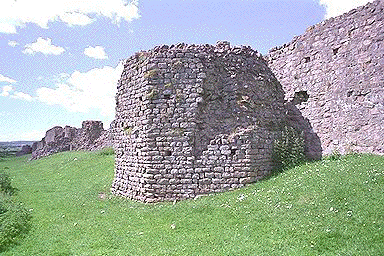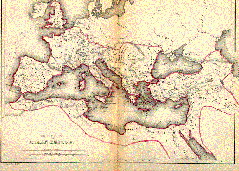

|
|
Britain After Roman Rule

Venta Siluris, Caerwent - South WalesWith the withdrawal of both Roman legions, the Picts, Scots and Saxons began a series of devastating attacks on the province. The Chronicle of 452 says for the year AD 408: 'Britain was devastated by an attack of the Saxons'. Prosper (Tiro) of Aquitaine states in his "Chronicle": "in the fifteenth year of Honorius and Arcadius (409), on account of the languishing state of the Romans, the strength of the Britons was brought to a desperate pass." The Britons took defences into their own hands, expelling the remaining Roman officials. According to Prosper, Britain was ruled by petty "tyrants."
Zosimus (VI, 5, 2-3) describes events in the following way:
'The barbarians beyond the Rhine, attacking in force, reduced the inhabitants of Britain and some of the Celtic tribes to the point where they were obliged to throw off Roman rule and live independently, no longer subject to Roman laws. The Britons therefore took up arms and, braving the danger on their own behalf, freed their cities from the barbarians threatening them. And all Armorica (Brittany) and the other Gallic provinces followed their example, freed themslves in the same way, expelled their Roman rulers and set up their own governments as far as lay within their power.'He goes on (VI, 10, 2):
'Honorius wrote letters to the cities in Britain bidding them to take precautions on their own behalf.Barbara Yorke (2009:48 'Britain and Ireland, c.500' in A Companion to the Early Middle Ages: Britain and Ireland c.500-1100 Wiley-Blackwell, edited by Pauline Stafford ) notes that the situation varied considerably across Roman Britain, with the west and north apparently forming new polities very quickly:
'In the provinces of Britannia Prima (Wales and the south-west), Britannia Secunda (the north), and the military zone, north of Hadrian's Wall, in Southern Scotland, kingdoms had developed by 500 or soon after, and local "big men" may have begun a consolidation of power as Roman effectiveness waned in the latter part of the fourth century. In these areas, there is little sign in the archaeological evidence of any major disruption or shift of settlement between 400 and 500."She considers that concessions to local rule in the west may have begun in the late 4th century under the administration of Magnus Maximus who has a significant role in Welsh mythology. Gildas refers to five 'tyrants' or local rulers:
- Constantine of Dumnonia - the south-west peninsula
- Vortipor of Dyfed
- Maglocunus of Gwynedd
- Aurelius Caninus
- Cuneglasus
The exact location of the last two is unclear, but Yorke contends that 'the medieval kingdoms of Wales can broadly be seen as evolving out of the Roman political geography of the region.' Similarly, northern kingdoms such as Gododdin (based on Edinburgh), Dumbarton - which as Strathclyde survived until the 10th century - and Rheged evolved by 500. Bernicia and Deira may also have their roots in British kingdoms of the period. It is more difficult to identify what happened in the south and the east of Britain.
The February 2012 edition of Current Archaeology includes an article on "Binchester After Rome" by David Mason reviewing the use of a Roman fort in County Durham well into the 5th Century with metal-working and an abattoir. The site also has burials in the 6th and later Centuries indicating continuation of use. Like the Hadrian's Wall forts, garrison and local inhabitants remained to form the nucleus of 'petty kingdoms' in the early medieval period.

The Roman empire at its greatest extent

By Dr Miles Russell
The chapters in this volume, each written by a leading scholar of the period, analyse in turn the different nationalities and kingdoms that existed in the British Isles from the end of the Roman empire to the coming of the Vikings, the process of conversion to Christianity, the development of art and of a written culture, and the interaction between this written culture and the societies of the day. Available from:Amazon.co.uk - British pounds
Amazon.com - US dollars
Amazon.ca - Canadian dollars
Amazon.de - Euros
Amazon.fr - Euros
Copyright © 2009-2025 Alan Price and IslandGuide.co.uk contributors. All rights reserved. Island Guide makes minimal use of cookies, including some placed to facilitate features such as Google Search. By continuing to use the site you are agreeing to the use of cookies. Learn more here